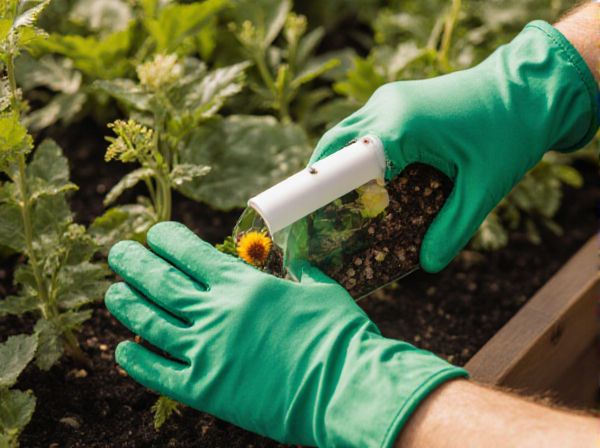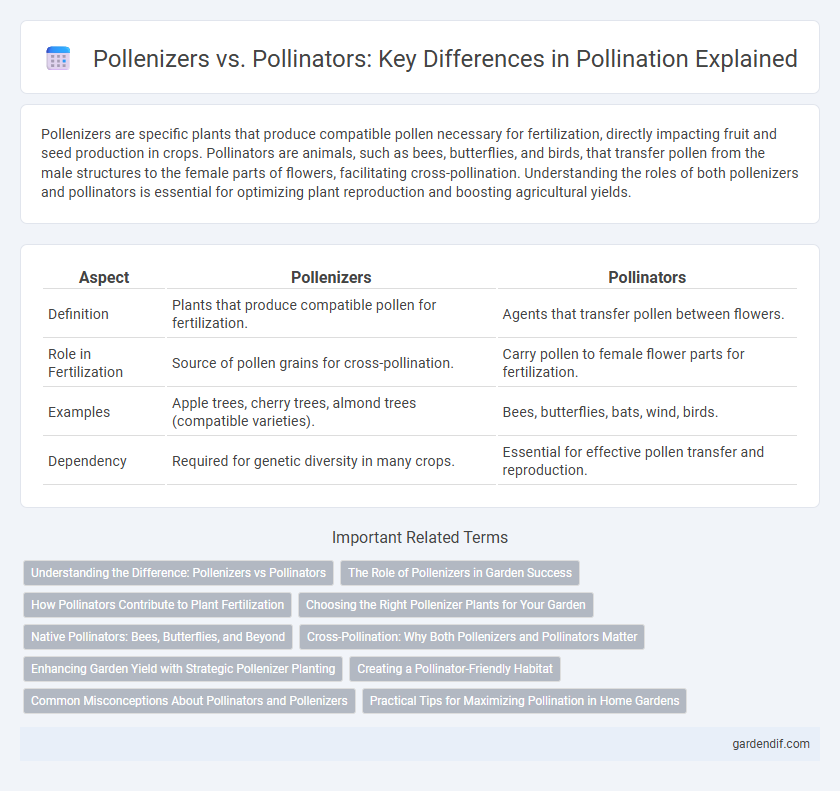
Pollenizers vs Pollinators Illustration
Pollenizers are specific plants that produce compatible pollen necessary for fertilization, directly impacting fruit and seed production in crops. Pollinators are animals, such as bees, butterflies, and birds, that transfer pollen from the male structures to the female parts of flowers, facilitating cross-pollination. Understanding the roles of both pollenizers and pollinators is essential for optimizing plant reproduction and boosting agricultural yields.
Table of Comparison
| Aspect | Pollenizers | Pollinators |
|---|---|---|
| Definition | Plants that produce compatible pollen for fertilization. | Agents that transfer pollen between flowers. |
| Role in Fertilization | Source of pollen grains for cross-pollination. | Carry pollen to female flower parts for fertilization. |
| Examples | Apple trees, cherry trees, almond trees (compatible varieties). | Bees, butterflies, bats, wind, birds. |
| Dependency | Required for genetic diversity in many crops. | Essential for effective pollen transfer and reproduction. |
Understanding the Difference: Pollenizers vs Pollinators
Pollenizers are plants or trees that produce and release pollen needed for fertilization, while pollinators are animals, such as bees, butterflies, or birds, that transfer pollen from one flower to another. Understanding the difference highlights that pollenizers are the source of pollen, whereas pollinators actively facilitate the reproductive process by moving pollen between flowers. This distinction is crucial for optimizing crop production and maintaining biodiversity in ecosystems reliant on pollination services.
The Role of Pollenizers in Garden Success
Pollenizers are specific plants that provide viable pollen essential for the fertilization and fruit production of pollinator-dependent species, directly influencing garden yields. Unlike pollinators, which transfer pollen between flowers, pollenizers supply the genetic material necessary for cross-pollination, enabling healthy seed and fruit development. Strategic selection of compatible pollenizer plants enhances biodiversity and maximizes fruit set, ensuring a thriving and productive garden ecosystem.
How Pollinators Contribute to Plant Fertilization
Pollinators, such as bees, butterflies, and birds, actively transfer pollen from the male anthers of a flower to the female stigma, facilitating cross-pollination and genetic diversity in plants. This transfer is crucial for the fertilization process, enabling the production of seeds and fruits necessary for plant reproduction. Unlike pollenizers, which are plants that provide pollen, pollinators enable the actual movement of pollen, directly contributing to successful plant fertilization and ecosystem sustainability.
Choosing the Right Pollenizer Plants for Your Garden
Selecting the right pollenizer plants enhances fruit set by providing compatible pollen for pollinators like bees and butterflies. It is crucial to choose pollenizer varieties that bloom simultaneously with your primary fruit plants and are genetically compatible to ensure successful cross-pollination. Planting diverse pollenizer species increases genetic diversity and improves the overall health and yield of your garden.
Native Pollinators: Bees, Butterflies, and Beyond
Native pollinators such as bees, butterflies, moths, beetles, and hummingbirds play a crucial role in the fertilization of plants by transferring pollen directly from one flower to another, enabling fruit and seed production. Unlike pollenizers, which are plants that provide pollen, pollinators actively collect and distribute pollen while feeding on nectar, promoting biodiversity and ecosystem health. Protecting diverse native pollinator species ensures effective pollination services and supports agricultural productivity and wild plant reproduction.
Cross-Pollination: Why Both Pollenizers and Pollinators Matter
Cross-pollination relies on pollenizers, which are plants that produce compatible pollen, and pollinators, the agents like bees or butterflies that transfer this pollen between flowers. Effective cross-pollination enhances genetic diversity and improves fruit quality and yield in crops such as apples and almonds. Both pollenizers and pollinators are crucial for successful reproduction, ecosystem health, and agricultural productivity.
Enhancing Garden Yield with Strategic Pollenizer Planting
Strategic pollenizer planting significantly boosts garden yield by ensuring effective cross-pollination between compatible plant varieties, increasing fruit set and quality. While pollinators like bees transfer pollen, pollenizers provide the necessary genetic diversity through compatible pollen sources. Selecting and positioning pollenizer plants nearby main crops optimizes pollination efficiency and maximizes overall productivity.
Creating a Pollinator-Friendly Habitat
Pollinators like bees, butterflies, and hummingbirds actively transfer pollen from one flower to another, enabling plant fertilization and fruit production, while pollenizers are specific plants that produce the pollen necessary for this process. Creating a pollinator-friendly habitat involves planting diverse native flowering species that bloom at different times, providing continuous nectar sources and shelter. Incorporating trees, shrubs, and ground cover enhances habitat complexity, supporting a wide range of pollinators and promoting ecosystem balance.
Common Misconceptions About Pollinators and Pollenizers
Pollinators are primarily animals like bees, butterflies, and birds that transfer pollen from one flower to another, facilitating fertilization and fruit production, whereas pollenizers refer to plants that provide viable pollen. A common misconception is that pollenizers and pollinators are interchangeable terms; however, pollenizers are not agents but sources of pollen. Understanding the distinction is crucial for effective agricultural practices and ecosystem management to ensure successful pollination and crop yields.
Practical Tips for Maximizing Pollination in Home Gardens
Pollenizers are specific plants that provide compatible pollen necessary for fertilizing flowers, while pollinators are insects or animals that transfer pollen between flowers. To maximize pollination in home gardens, plant a diverse mix of compatible pollenizer species alongside your main crops and provide habitats that attract pollinators like bees and butterflies. Incorporate flowering plants with staggered bloom times to ensure continuous pollen availability and enhance pollination efficiency throughout the growing season.
Pollenizers vs Pollinators Infographic

 gardendif.com
gardendif.com